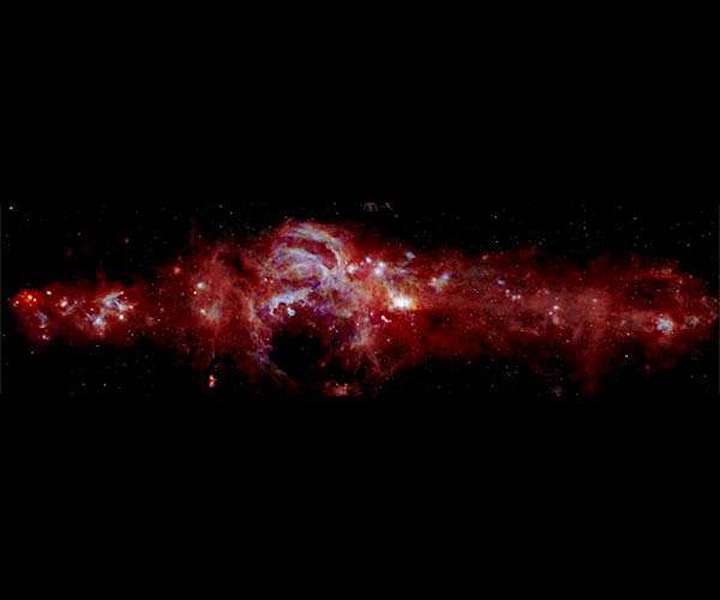7.01.2020

Composite infrared image of the center of our Milky Way galaxy. It spans 600+ light-years across and is helping scientists learn how many massive stars are forming in our galaxy's center. New data from SOFIA taken at 25 and 37 microns, shown in blue and green, is combined with data from the Herschel Space Observatory, shown in red (70 microns), and the Spitzer Space Telescope, shown in white (8 microns). SOFIA's view reveals features that have never been seen before
-
Universities Space Research Association has announced that SOFIA has revealed a new infrared view of the center of our Milky Way galaxy, showing never-before-seen details, and revealing structures indicative of star birth.
NASA's telescope has captured an extremely crisp infrared image of the center of our Milky Way galaxy. Spanning a distance of more than 600 light-years, this panorama reveals details within the dense swirls of gas and dust in high resolution, opening the door to future research into how massive stars are forming and what's feeding the supermassive black hole at our galaxy's core.
Among the features coming into focus are the jutting curves of the Arches Cluster containing the densest concentration of stars in our galaxy, as well as the Quintuplet Cluster with a stars a million times brighter than our Sun. Our galaxy's black hole takes shape with a glimpse of the fiery-looking ring of gas surrounding it.
The new view was made possible by the world's largest airborne telescope, the Stratospheric Observatory for Infrared Astronomy, or SOFIA. Flying high in the atmosphere, this modified Boeing 747 pointed its infrared camera called FORCAST - the Faint Object Infrared Camera for the SOFIA Telescope - to observe warm, galactic material emitting at wavelengths of light that other telescopes could not detect.
The image combines SOFIA's new perspective of warm regions with previous data exposing very hot and cold material from NASA's Spitzer Space Telescope and the European Space Agency's Herschel Space Observatory.
An overview paper highlighting initial results has been submitted for publication to the Astrophysical Journal. The image was presented for the first time at the American Astronomical Society annual meeting this week in 2020 in Honolulu.
"It's incredible to see our galactic center in detail we've never seen before," said James Radomski, a Universities Space Research Association scientist at the SOFIA Science Center at NASA's Ames Research Center in California's Silicon Valley. "Studying this area has been like trying to assemble a puzzle with missing pieces. The SOFIA data fills in some of the holes, putting us significantly closer to having a complete picture."
Birth of Stars
The Milky Way's central regions have significantly more of the dense gas and dust that are the building blocks for new stars compared to other parts of the galaxy. Yet, there are 10 times fewer massive stars born here than expected. Understanding why this discrepancy exists has been difficult because of all the dust between Earth and the galactic core getting in the way - but observing with infrared light offers a closer look at the situation.
The new infrared data illuminates structures indicative of star birth near the Quintuplet Cluster and warm material near the Arches Cluster that could be the seeds for new stars. Seeing these warm features in high resolution may help scientists explain how some of the most massive stars in our entire galaxy managed to form so close to each other, in a relatively small region, despite the low birthrate in the surrounding areas.
"Understanding how massive star birth happens at the center of our own galaxy gives us information that can help us learn about other, more distant galaxies," said Matthew Hankins, a postdoctoral scholar at the California Institute of Technology in Pasadena, California and principal investigator of the project. "Using multiple telescopes gives us clues we need to understand these processes, and there's still more to be uncovered."
Ring Around the Black Hole
Scientists can also more clearly see the material that may be feeding the ring around our galaxy's central supermassive black hole. The ring is about 10 light-years in diameter and plays a key role in bringing matter closer to the black hole, where it may eventually be devoured. The origin of this ring has long been a puzzle for scientists because it may be depleted over time, but the SOFIA data reveal several structures which could represent material being incorporated into it.
The data were taken in July 2019 during SOFIA's annual deployment to Christchurch, New Zealand, where scientists study the skies over the Southern Hemisphere. The full, calibrated dataset is currently available to astronomers worldwide for further research via the SOFIA Legacy Program.
Quelle: SD
